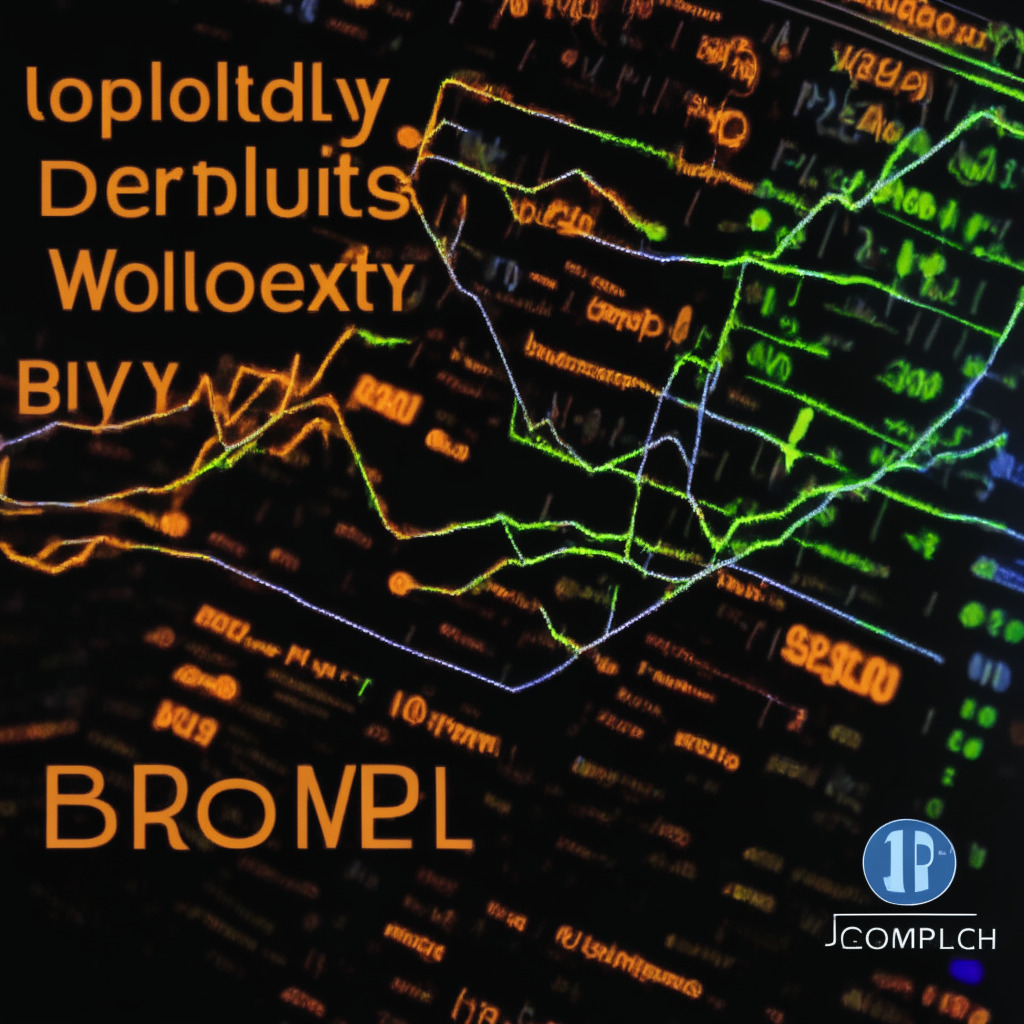Binance experienced a decline in trading volumes and liquidity in Q1 2023 due to U.S. banking failures and termination of its zero-fee promotion. This resulted in increased Bitcoin price volatility and a sharp drop in monthly trading volumes for the BTC-USDT pair.
Search Results for: Reserve
Banking Crisis Fines: Will Traditional Finance Giants Embrace Crypto Amid Increased Scrutiny?
The U.S. SEC fined HSBC Securities ($15 million) and Scotia Capital ($7.5 million) for recordkeeping violations, as employees used unauthorized communication channels like text messages and WhatsApp. This ongoing tension between traditional finance and emerging digital assets raises questions about the future of cryptocurrency adoption.
Bitcoin Plunges Amid Dollar Strength and Slowing Ordinals: Crypto Market at Risk?
Bitcoin drops to a two-month low of $26,188 amid rising dollar strength and slowdown in Ordinals hype. The entire crypto market reported a 3% loss, with total liquidations reaching $143 million. Despite these events, it’s crucial for crypto enthusiasts to focus on the potential advantages of blockchain technology and foster an informed community.
Central Banks Vetoing Stablecoins: Balancing Innovation and Financial Stability in the EU
EBA Chair José Manuel Campa emphasizes the need for stablecoins to adhere to sensible guardrails, as central banks should have the right to veto if they threaten monetary policy or financial stability. MiCA’s introduction will regulate all crypto-related activities in the EU, ensuring stablecoin issuers comply with vital regulations while considering central banks’ role.
Balancing Bank Regulations: Can Overregulation Hinder Progress and Create a False Security?
JPMorgan Chase CEO Jamie Dimon highlights potential troubles for U.S. banks due to overregulation and its obstructive impact on business practices. Emphasizing the need for a more holistic approach to regulations, Dimon suggests that solely relying on stress tests and overregulation may create a false sense of security and detract from addressing crucial vulnerabilities in the banking industry.
Silvergate Bank Collapse: Lessons Learned on Crypto Regulations and Finance Challenges
Silvergate Capital will be delisting from the NYSE and cutting 230 staff members following a 93% decline in share price since 2023. The company faces regulatory inquiries and investigations, while its liquidation process emphasizes the importance of regulations and scrutiny for financial institutions connected to the cryptocurrency market.
Crypto Slump: Analyzing Underlying Factors and Potential Investment Gems
Bitcoin dipped below $27,500, neutralizing gains from U.S. inflation data and experiencing a 7.57% decrease in price over the past month. Changing macroeconomic conditions and interest rate hikes contribute to the decline, yet Bitcoin whales show a bullish divergence by acquiring 0.29% of supply.
FedNow and Metal Blockchain Integration: Stablecoins, Privacy, and Financial Future Debated
The Federal Reserve’s upcoming integration with Metal Blockchain has sparked debates on stablecoins, privacy, and financial system plans. Metal Blockchain’s collaboration with instant payment service FedNow aims to enable rapid stablecoin conversions and potentially create interconnected “bank chains” for a secure, oracle-independent blockchain ecosystem.
Soaring Profits for Tether: Stablecoin Industry Boom and USDT Token Holder Concerns
Tether reported a record profit of $1.48 billion in Q1 2021, attributed to rising interest rates and diversifying its reserves with physical gold and Bitcoin. The stablecoin issuer sees a 20% increase in token circulation, reflecting growing customer trust. However, concerns arise as USDT token holders receive no interest, and companies need to balance profits and customer interests for sustainable growth.
2023 Crypto Crackdown: Operation Choke Point 2.0 vs Banking Industry Collapse
The US regulators’ crackdown on the crypto market has led to the closure of Silvergate, Silicon Valley Bank, and Signature, while prominent figures criticize scapegoating cryptocurrencies for the banking crisis. The House Financial Services Committee investigates potential coordinated efforts to de-bank the crypto market as the banking crisis worsens.
Surge in Bitcoin Transaction Fees: Boon for Miners, Bane for Users, Glimpse into Blockchain’s Future
The recent surge in Bitcoin transaction fees due to the Ordinals protocol’s impact on non-fungible and fungible tokens has both positive and negative implications for the mining industry and crypto ecosystem, highlighting the need for innovation and adaptability in navigating future challenges and opportunities.
Texas Moves to Amend Bill of Rights for Crypto: A Milestone in Mainstream Acceptance?
Texas lawmakers passed a joint resolution to amend the state’s bill of rights to include the right to own, hold, and use digital currencies, reflecting mainstream acceptance. The bill, HJR 146, emphasizes that government shall not prohibit or encumber any form or amount of money, including digital currencies. The outcome of this vote will be crucial in shaping the industry’s future.
Exploring Offline CBDC Payments: Balancing Privacy, Fraud, and Accessibility
The Bank for International Settlements (BIS) explores offline central bank digital currency (CBDC) payments and their potential risks, including counterfeit threats and privacy issues, in a collaborative project with Consult Hyperion. The BIS emphasizes the importance of interoperability, risk management systems, and collaboration between public and private sectors for secure and reliable digital currency environments.
The Need for Regulating Crypto Custodians: Safeguarding Digital Assets and Building Trust
A robust regulatory framework specifically designed for custodians is crucial in the evolving cryptocurrency industry. Custodians mitigate risks by safeguarding digital assets, separating them from exchanges. Governments must establish transparent rules enabling custodians to operate legally, ensuring investor protection and a secure ecosystem.
Cross-Chain Collaboration: tBTC, Wormhole Boost Bitcoin Presence in DeFi Ecosystems
Threshold Network and Wormhole have collaborated to enable smooth movement of tokenized bitcoin (tBTC) across nearly 20 blockchain ecosystems, aiming to make tBTC the leading bitcoin representative in on-chain DeFi. Wormhole’s bridging plan offers a fresh, secure approach, addressing centralization risks and fostering a more secure environment for bitcoin adoption.
Animoca Brands Fights Valuation Collapse Claims, Showcases Financial Strength in Web3 Gaming
Animoca Brands’ recent interim financial report shows $3.4 billion in assets and strong financial figures, countering allegations of financial struggles and valuation decreases. The company’s commitment to increased transparency strengthens trust within the crypto community and highlights the growing significance of Web3 and the metaverse in gaming.
Central Banks’ Veto Powers and Stablecoin Risks: Safeguarding Financial Stability in a MiCA Future
European Banking Authority Chair José Manuel Campa calls for central bank veto powers over large stablecoins, citing concerns for financial stability and public policy. The upcoming Markets in Crypto Assets (MiCA) regulation sets guidelines and requirements for stablecoin issuers, including stringent authorization and supervision processes.
Stablecoins as Bail Payments: Innovation or Uncertainty for New York’s Justice System?
New York’s Assembly Bill 7024, introduced by Assemblywoman Latrice Walker, proposes authorizing fiat-collateralized stablecoins as bail payment options. If enacted, it could modernize and streamline the payment process, offering increased efficiency while disrupting traditional bail payment methods. However, critics caution against potential unforeseen challenges in the justice system.
CleanSpark’s Bitcoin Mining Growth Amid Halving Event: Eco-friendly or Greenwashing?
US-based Bitcoin mining company CleanSpark Inc. has doubled its mined Bitcoin in the last quarter compared to Q2 of the previous year but experienced limited revenue growth due to struggling Bitcoin prices. CleanSpark’s CFO, Gary A. Vecchiarelli, mentioned the company’s improved hash rate and CEO Zach Bradford discussed the upcoming Bitcoin halving event, emphasizing efficient mining practices.
Stablecoin Issuers Adapt Strategies Amid US Debt Ceiling Crisis: Different Approaches Compared
Stablecoin issuer Circle has revised its reserve treasury strategy to mitigate potential risks from a US debt default, converting to short-dated U.S. Treasuries. As stakeholders in the blockchain industry adjust strategies, Circle aims to insulate itself from risks associated with a possible U.S. debt crisis.
Crypto Derivatives Boom: New Opportunities and Risks in a Centralized Landscape
The crypto derivatives market reached a new all-time high of 77.6% market share despite a 23.3% decrease in trading volume. This trend highlights the industry’s speculative nature and has raised concerns about centralization and potential manipulation in the sector.
Tether’s Bitcoin and Precious Metals Investments: Transparency Boost or Market Risk?
Tether’s recent attestation report reveals approximately $1.5 billion worth of Bitcoin, accounting for nearly 2% of its total reserves. The inclusion of Bitcoin and precious metals, totaling $3.4 billion, aims to enhance transparency for USDT stablecoin holders. However, concerns arise about potential risks due to market fluctuations.
Ethereum Struggles at $2,000: Analyzing Futures, Memecoin Frenzy, and Fed Impact
Ether recently surpassed $2,000 but retreated back to its familiar range between $1,820 and $1,950. Despite the memecoin frenzy increasing Ethereum network demand, investors’ confidence remained low. Weak derivatives indicators may become more bearish if the sideways movement breaks to the downside.
US House Committee Seeks Crypto Clarity Amid SEC Contradictions and Offshore Exodus
The U.S. House Financial Services Committee aims to clarify digital asset regulations amid contradictory actions from SEC Chair Gary Gensler. As U.S.-based crypto firms consider moving offshore due to regulatory crackdowns, upcoming hearings will address regulatory gaps and potential coordinated efforts by regulators for “Operation Choke Point 2.0” to de-bank the crypto market.
Tether’s Record Profits Amid Transparency Concerns: An In-Depth Analysis of the Stablecoin Giant
Tether announced a net profit of $1.48 billion and a reserve surplus of $2.44 billion. As the company behind USDT, the largest stablecoin, Tether plays a vital role in crypto markets. However, it faces scrutiny over transparency in backing USDT with U.S. dollars and has faced controversies in the past.
US Inflation Data Impact on Bitcoin: Analyzing Market Reactions and Future Predictions
The latest US Consumer Price Index (CPI) inflation data suggests easier monetary policy conditions ahead, which generally benefit Bitcoin. Despite potential short-term concerns, Bitcoin’s long-term bull market thesis is likely to remain intact. The US bank crisis could boost demand for “hard money” alternatives like Bitcoin and gold.
Tether’s $1.48B Q1 Profit: Can Success Amid Transparency Concerns Sustain?
Tether reported a $1.48 billion net profit in Q1 2021 and disclosed its $1.5 billion Bitcoin and $3.4 billion gold holdings. Despite scrutiny, Tether’s USDT stablecoin remains a market leader. Increased transparency efforts include reducing secured loans in reserves and providing clearer information on reserve assets.
Crypto Market Volatility: Powell’s Impact, Buffett’s Decisions, and Network Fees Debated
Marcel Pechman discusses factors contributing to crypto market volatility, including BTC’s price fluctuations, Federal Reserve interest rate decisions, and the potential impact on BTC if interest rates remain above 5%. He also examines Warren Buffett’s investment decisions, BTC network fees, and the Lightning Network.
Inflation Rate Impact on Crypto: Analyzing Support & Resistance in the Market
The US consumer price index (CPI) rose by 4.9% annually, and the slower pace supports the effectiveness of Federal Reserve rate hikes. Cryptocurrency market responded favorably, with Bitcoin price surpassing $28,000. Price analysis for Bitcoin and major altcoins reveals critical support and resistance levels to watch in current market.
US Inflation Decline: A Boon or Bane for Bitcoin and Cryptocurrency Markets?
The U.S. inflation decline and anticipated pause in June’s rate hike could increase investor interest in cryptocurrencies like Bitcoin. However, high core CPI and potential BTC volatility due to reduced liquidity must be considered by investors.
EU’s MiCA Regulation: Impact on Crypto Assets, Stablecoins and NFTs, and Investor Protections
The European Union is preparing to implement the Markets in Crypto Assets (MiCA) regulation by July 2023, covering crypto-assets and their issuance, trading, and offering. MiCA aims to update the EU with new technologies, introducing stricter rules on stablecoins, increased disclosure obligations for crypto businesses, and implementing anti-money laundering and data security procedures. However, it does not apply to non-fungible tokens (NFTs).
Reddit Moderators Stand Against Crypto in Pepe Subreddits: Examining the Conflict
Reddit moderators have banned cryptocurrency promotion, including NFTs, in the “r/pepethefrog” subreddit to maintain focus on Pepe the Frog art. The decision comes amid a flood of crypto content due to the recent $PEPE memecoin frenzy. Members overwhelmingly support the action, demonstrating the importance of setting boundaries between art and cryptocurrency in the digital age.































